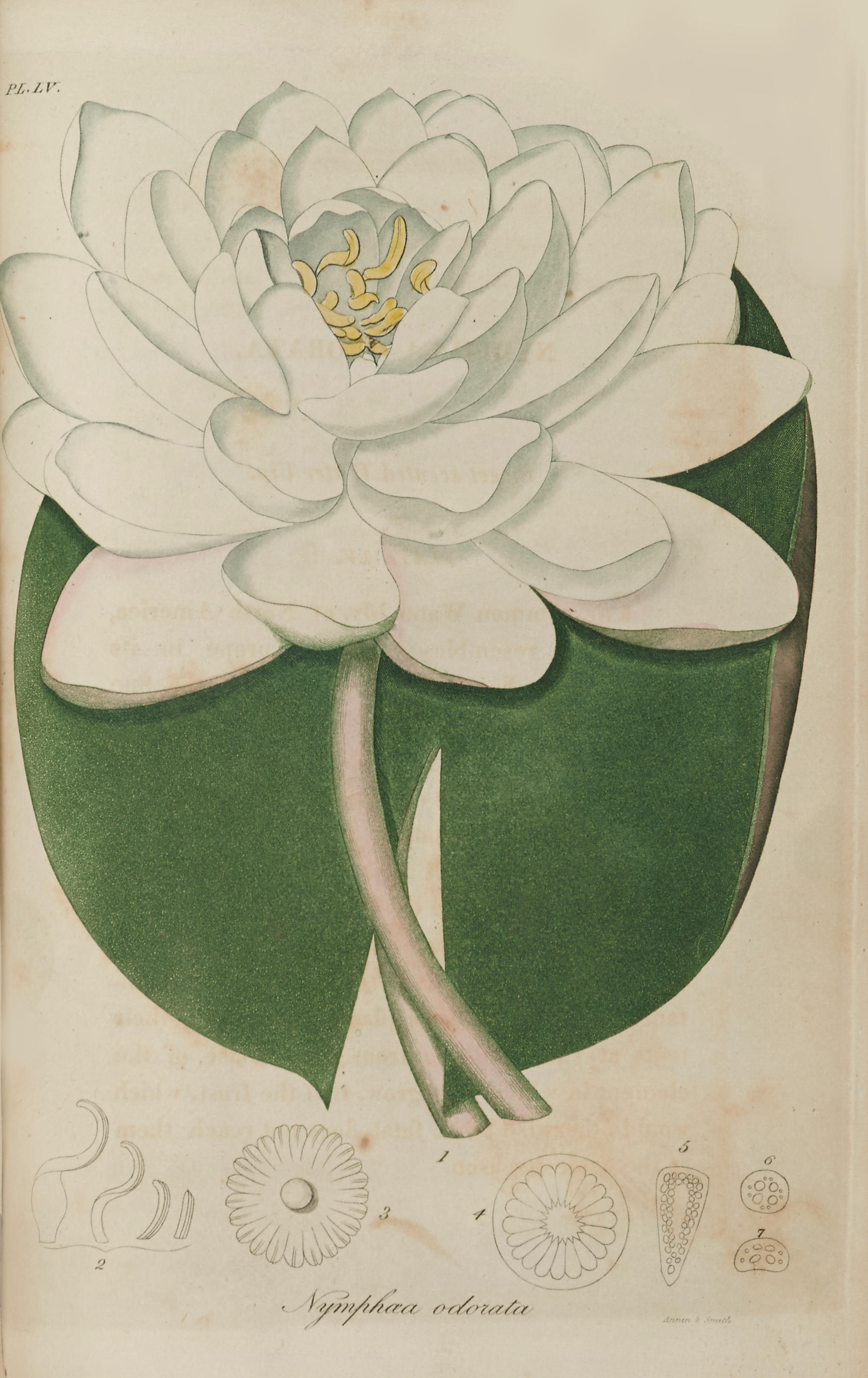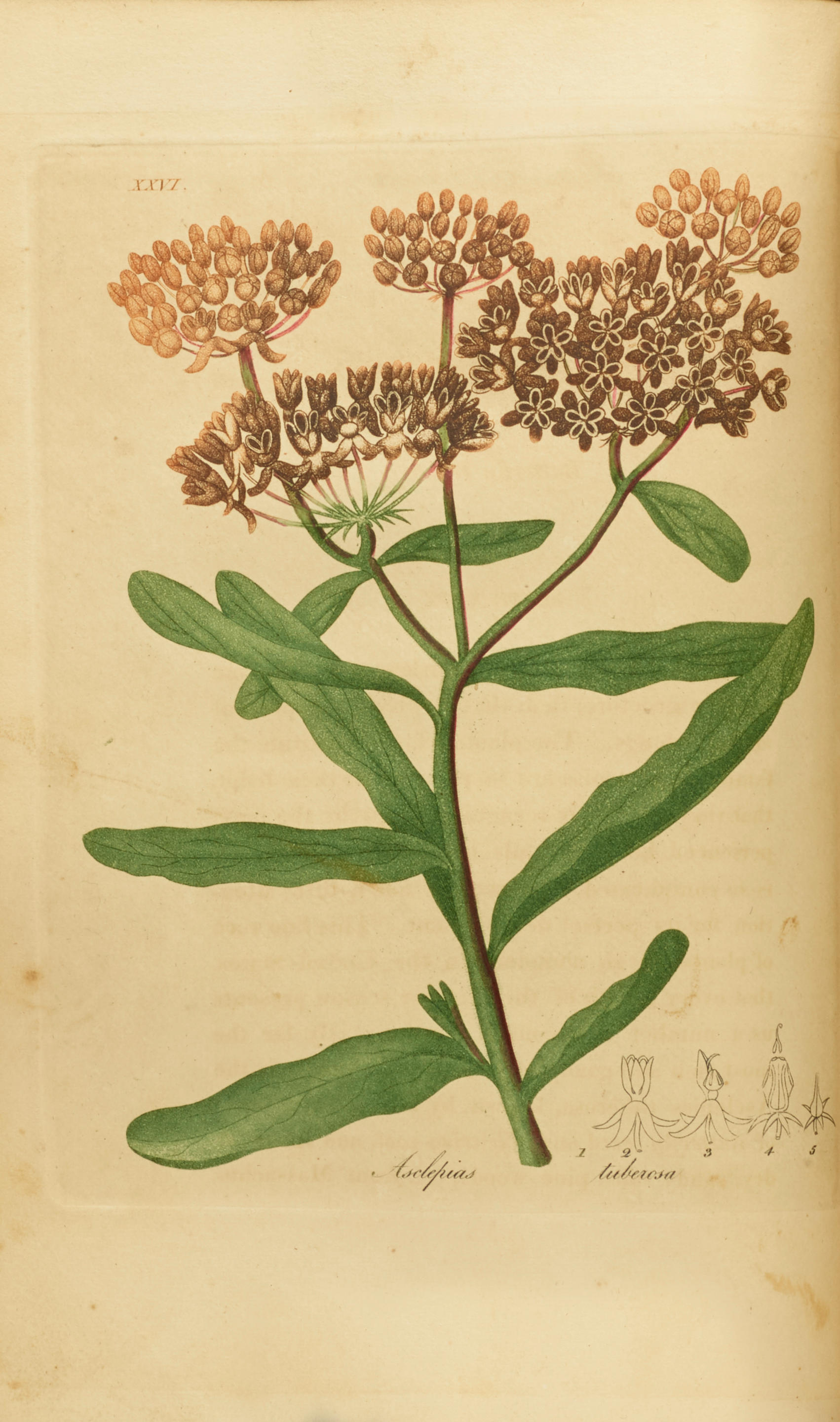JACOB BIGELOW (1787-1879) American Medical Botany, being a collection of the native medicinal plants of the United States, containing their botanical history and chemical analysis, and properties and uses in medicine, diet and the arts, with colored engravings. Boston: Cummings and Hilliard, 1817-1821. 6 parts in 3 volumes, 4 (246 x 168mm). Six section titles, three volume titles. 60 coloured plates comprising 10 hand-coloured copper engravings and 50 plates printed in colours, probably from an etched stone, some finished by hand. (Light offsetting of text onto plates, occasional slight smudging.) Later 19th-century black half morocco, spine gilt in six compartments with raised bands, lettered in the second and fourth (some scuffing to joints). Provenance : Francis Brooks (armorial bookplate). FIRST EDITION, FIRST STATE, OF THE FIRST BOOK PRINTED IN THE UNITED STATES WITH PLATES PRINTED IN COLOURS. Jacob Bigelow, professor of materia medica at Harvard, was one of America's greatest botanists. He "originally intended to illustrate his massive work in traditional fashion with hand-colored copperplates, hiring the engraver William B. Annin and numerous colorists to produce the plates for Vol. I, part I. Finding the process too slow and expensive, Bigelow searched for a method that would allow the swift and easy application of color directly onto the plate, as well as rapid cleaning of the plate between impressions. Richard J. Wolfe has shown that Bigelow turned to a printing process involving etched stone, a technique developed in Europe shortly before Alois Senefelder's invention of lithography in 1795-1796; it is likely, however, that Bigelow and his engravers discovered this technique independently, as printing from stone was little known in America at this time" (Norman 234). Only the earliest copies of the work include the ten hand-coloured engraved plates, the colour prints were substituted as soon as the process of stone-printing was perfected. Austin 205; Bennett p.11; Johnston Cleveland Botanical 804; Cushing B384; Garrison-Morton 1842; Heirs of Hippocrates 1444; Nissen BBI 164; Norman 234; Pritzel 733; Roylance, American Graphic Arts (Princeton 1990) p.94; Sabin 5294; Stafleu & Cowan 514; R.J. Wolfe Jacob Bigelow's American Medical Botany (1979), chapters 3 & 4. (3)
JACOB BIGELOW (1787-1879) American Medical Botany, being a collection of the native medicinal plants of the United States, containing their botanical history and chemical analysis, and properties and uses in medicine, diet and the arts, with colored engravings. Boston: Cummings and Hilliard, 1817-1821. 6 parts in 3 volumes, 4 (246 x 168mm). Six section titles, three volume titles. 60 coloured plates comprising 10 hand-coloured copper engravings and 50 plates printed in colours, probably from an etched stone, some finished by hand. (Light offsetting of text onto plates, occasional slight smudging.) Later 19th-century black half morocco, spine gilt in six compartments with raised bands, lettered in the second and fourth (some scuffing to joints). Provenance : Francis Brooks (armorial bookplate). FIRST EDITION, FIRST STATE, OF THE FIRST BOOK PRINTED IN THE UNITED STATES WITH PLATES PRINTED IN COLOURS. Jacob Bigelow, professor of materia medica at Harvard, was one of America's greatest botanists. He "originally intended to illustrate his massive work in traditional fashion with hand-colored copperplates, hiring the engraver William B. Annin and numerous colorists to produce the plates for Vol. I, part I. Finding the process too slow and expensive, Bigelow searched for a method that would allow the swift and easy application of color directly onto the plate, as well as rapid cleaning of the plate between impressions. Richard J. Wolfe has shown that Bigelow turned to a printing process involving etched stone, a technique developed in Europe shortly before Alois Senefelder's invention of lithography in 1795-1796; it is likely, however, that Bigelow and his engravers discovered this technique independently, as printing from stone was little known in America at this time" (Norman 234). Only the earliest copies of the work include the ten hand-coloured engraved plates, the colour prints were substituted as soon as the process of stone-printing was perfected. Austin 205; Bennett p.11; Johnston Cleveland Botanical 804; Cushing B384; Garrison-Morton 1842; Heirs of Hippocrates 1444; Nissen BBI 164; Norman 234; Pritzel 733; Roylance, American Graphic Arts (Princeton 1990) p.94; Sabin 5294; Stafleu & Cowan 514; R.J. Wolfe Jacob Bigelow's American Medical Botany (1979), chapters 3 & 4. (3)








.jpg)

Try LotSearch and its premium features for 7 days - without any costs!
Be notified automatically about new items in upcoming auctions.
Create an alert